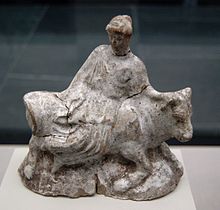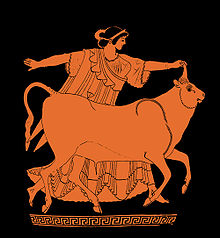Europe (daughter of Agenor)

( terracotta group from Athens, around 470 BC, Staatliche Antikensammlungen in Munich)
Europe ( ancient Greek Εὐρώπη , ancient Greek pronunciation Eurṓpē ; for more information on the name see Europe ), a figure in Greek mythology , is the daughter of the Phoenician king Agenor and Telephassa . Zeus fell in love with her. He turned into a bull because of his suspicious wife Hera . His messenger Hermes drove a herd of bulls near the Europa playing on Sidon beach , which the Zeus bull kidnapped on his back. He swam with her to Matala on the island of Crete , where he changed back. The connection with the god gave birth to three children: Minos , Rhadamanthys and Sarpedon . Due to a promise made by Aphrodite , the foreign continent was named after Europe.
stories
The oldest literary reference to Europe in the Iliad of Homer to find where she was the daughter of Phoinix is. Ancient narratives of the European myth can be found in the “Europa” of Moschos and in the “ Metamorphoses ” of Ovid . There are many different legends about the kidnapping of Europe.
According to Ovid, Jupiter (Roman for Zeus) turns into a bull, a particularly strong but very peaceful-looking specimen with pure, snow-white fur and small horns that look as if they were made by an artist. Jupiter mingles with a herd of royal bulls that Mercurius (Roman for Hermes) had previously driven to the beach, and thus approaches Europe, which is on the beach with her companions. Europe's fear is soon overcome, she plays with the bull, feeds him, caresses him and winds his horns with flowers. Finally she dares to get on his back - then the bull goes into the water and swims out to sea. He brings her to Crete , where he sheds his bull form and reveals himself.
Agenor sent his sons to look for their sister, Europa, but the investigation was unsuccessful. Finally, Kadmos questions the oracle of Delphi and is instructed by the latter to give up the search for his sister and instead found the Boeotian city of Thebes .
According to other sources, Europe is said to have given birth to three sons after the affair with Zeus. She was then married by Asterios , the King of Crete, and thus became Queen of Crete. Asterios, who had no children himself, also adopted her three sons.
Gerold Dommermuth-Gudrich points out that the Roman version of this legend is essentially an oriental one: Europe is “nothing more than the embodiment of Ishtar or Astarte , the Babylonian-Syrian goddess of love, whom the Greeks equate with Aphrodite . Even at the time of classical Hellenism, Europe was revered as Europa-Astarte by the Phoenicians in Sidon ”.
interpretation
The historian Annette Kuhn counters the myth, which is patriarchal in the Ovid tradition , with an alternative reading that incorporates the early matriarchy . This is how she sees the matriarchy at work when the mother of Europe, Telephassa, imposed a punishment on Zeus for his foolish behavior towards Europe, namely the denial of the love of Europe and the death of nature. She interprets the myth to the effect that Zeus was only able to approach Europe in the "disguise" as a bull, which functioned as a symbol for matriarchal order - derived from the mythological symbol of the "cosmic cow", which was still widespread at the time. "Love, that is the simple message, cannot be forced."
Kuhn u. a. on the myth researcher Robert von Ranke-Graves, who "in his source-critical retelling of European history [already] pointed to [a] matriarchal tradition".
presentation
The oldest vase paintings discovered, which clearly depict Europe, date back to the 7th century BC. Later pictorial representations mostly show Europe, following Ovid's description, as she is kidnapped by the Zeus bull. She is usually only lightly dressed or completely naked, sits astride (in older depictions), sideways or half-lying (in more recent depictions) on the back of the white bull, clings to him and shows no signs of fear.
Use on euro banknotes
After Europe was already visible on the 5 DM note in 1948 , the head of the legendary figure has been depicted on the 5 € note in the watermark and in the hologram since May 2, 2013 , this is the smallest note of the second "Europe" Series “of euro banknotes. The new € 10 banknote, also with the image of Europe, has been in circulation since 23 September 2014. The portrait shown comes from a vase from southern Italy that is over 2000 years old and can be viewed in the Louvre in Paris.
See also
- Jupiter's moon Europa
- L'Europa riconosciuta , opera by Antonio Salieri
literature
- Johannes Hugo Helbig : Europe 10 . In: Wilhelm Heinrich Roscher (Hrsg.): Detailed lexicon of Greek and Roman mythology . Volume 1,1, Leipzig 1886, Col. 1410-1418 ( digitized version ).
- State museums Prussian cultural heritage Museum of arts and crafts : The seduction of Europe . Propylaeen Verlag, Berlin, 1988, ISBN 3-549-05872-1
-
D'Europe à l'Europe, I. Le mythe d'Europe dans l'art et la culture de l'antiquité au XVIIIe s. (colloque de Paris, ENS - Ulm, April 24-26, 1997), ed .: R. Poignault and O. Wattel-de Croizant, coll.Caesarodunum, n ° XXXI bis, 1998
- II. Mythe et identité du XIXe s. à nos jours (colloque de Caen, September 30 - October 2, 1999), ed. by R. Poignault, F. Lecocq and O. Wattel – de Croizant, coll. Caesarodunum, n ° XXXIII bis, 2000
- III. La dimension politique et religieuse du mythe d'Europe de l'Antiquité à nos jours (colloque de Paris, ENS-Ulm, November 29-30, 2001), éd. O. Wattel - De Croizant, coll.Caesarodunum, n ° hors-série, 2002
- IV. Entre Orient et Occident, du mythe à la geopolitique (colloque de Paris, ENS-Ulm, 18-20 May 2006), dir. O. Wattel-de Croizant & G. de Montifroy, Ed. de l'Age d'Homme, Lausanne 2007
- V. État des connaissances (colloque de Bruxelles, October 21-22, 2010), dir. O. Wattel-de Croizant & A. Roba, Brussels, éd. Métamorphoses d'Europe asbl, 2011.
- Günter Dietz : Europe and the bull . An ancient myth for Europe? Kulturgeschichtliche Reihe, 4. Sonnenberg, Annweiler 2003 ISBN 3-933264-29-4
- Almut-Barbara Renger (Ed.): Myth of Europe. Texts from Ovid to Heiner Müller . Reclam, Leipzig 2003 ISBN 3-379-20077-8
- Almut-Barbara Renger: Europe. In: Maria Moog-Grünewald (Ed.): Mythenrezeption. The ancient mythology in literature, music and art from the beginnings to the present (= Der Neue Pauly . Supplements. Volume 5). Metzler, Stuttgart / Weimar 2008, ISBN 978-3-476-02032-1 , pp. 276-285.
- Almut-Barbara Renger, Roland Alexander Ißler (Hrsg.): Founding myths of Europe in literature, music and art, 1: Europe - bull and wreath of stars. From the union with Zeus to the union of states . V&R unipress, Göttingen 2009, ISBN 978-3-89971-566-8
- Eva C. Huller: “Even Zeus realized how divided Europe was”. Europe in German-language literature since 1957. In: Christian Lohse, Joseph Mittlmeier (Hrsg.): Europäische Ursprung. Mythology and Modernity. Festschrift of the University of Regensburg for the 50th anniversary of the Treaty of Rome. Regensburg 2007, pp. 119–130. ISBN 3-9808020-9-4
- Winfried Bühler : Europe. Munich: W. Fink, 1968
Web links
- Europe myth in ancient literature and modern reception ( Memento from September 30, 2007 in the Internet Archive )
- approx. 250 photos of depictions of Heracles in art, in the Warburg Institute Iconographic Database
Individual evidence
- ↑ Homer , Iliad xiv. 321-322
- ↑ Ovid , Metamorphoses ii.833-875
- ↑ Bibliotheke of Apollodorus III.1.2
- ↑ Scholion to Homer, Iliad xii. 292
- ↑ Gerold Dommermuth-Gudrich: Myths. The most famous myths of ancient Greece, 50 classics . Hildesheim, 2000, p. 110.
- ↑ Anette Kuhn: Why is Europe sitting on the bull? Matriarchal foundations of Europe . In: Ministry for Generations, Family, Women and Integration of the State of North Rhine-Westphalia: Women are changing EUROPE is changing women . 2009 ( Archived copy ( Memento of the original from January 8, 2015 in the Internet Archive ) Info: The archive link was automatically inserted and not yet checked. Please check the original and archive link according to the instructions and then remove this notice. ).
- ↑ Anette Kuhn: Why is Europe sitting on the bull? Matriarchal foundations of Europe . In: Ministry for Generations, Family, Women and Integration of the State of North Rhine-Westphalia: Women are changing EUROPE is changing women . 2009 ( Archived copy ( memento of the original from January 8, 2015 in the Internet Archive ) Info: The archive link was automatically inserted and not yet checked. Please check the original and archive link according to the instructions and then remove this note. ) With reference to: Robert von Ranke-Graves: The Gods of Greece. The classic myths and legends . Reinbek b. Hamburg 1983, p. 58.
- ↑ Winfried Bühler , Europe: a collection of testimonies to myth in ancient literature and art
- ↑ The new 5-euro note in comparison ( Memento of the original from July 4, 2014 in the Internet Archive ) Info: The archive link was inserted automatically and has not yet been checked. Please check the original and archive link according to the instructions and then remove this notice. , European Central Bank
- ↑ The new face of the euro. (PDF) In: europa.eu. Retrieved June 25, 2015 .




